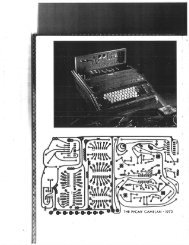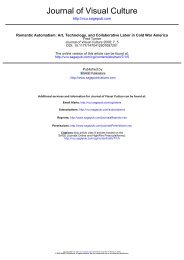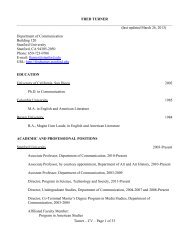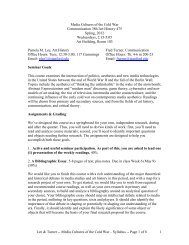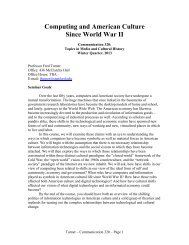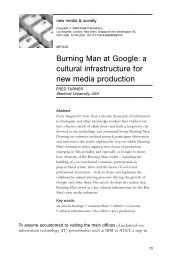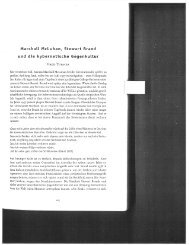The Family of Man and the Politics of Attention in ... - Public Culture
The Family of Man and the Politics of Attention in ... - Public Culture
The Family of Man and the Politics of Attention in ... - Public Culture
Create successful ePaper yourself
Turn your PDF publications into a flip-book with our unique Google optimized e-Paper software.
<strong>Public</strong> <strong>Culture</strong><br />
At <strong>the</strong> broadest level, such read<strong>in</strong>gs make sense. Steichen did <strong>in</strong>deed structure<br />
<strong>the</strong> show to take visitors from birth to death <strong>and</strong> even to rebirth at <strong>the</strong> end. Yet<br />
critics writ<strong>in</strong>g <strong>in</strong> this ve<strong>in</strong> have dramatically underplayed both <strong>the</strong> flexibility <strong>of</strong><br />
Rudolph’s <strong>in</strong>stallation <strong>and</strong> <strong>the</strong> range <strong>of</strong> social, racial, <strong>and</strong> national possibilities<br />
represented <strong>in</strong> <strong>the</strong> pictures on <strong>the</strong> walls. Seen from overhead, Rudolph’s plan for<br />
<strong>the</strong> exhibition reveals that it did not <strong>in</strong> fact require visitors to take each life stage<br />
<strong>in</strong> sequence. Nor did it dem<strong>and</strong> that <strong>the</strong>y move through <strong>the</strong> exhibition toge<strong>the</strong>r <strong>in</strong><br />
a herd. After enter<strong>in</strong>g <strong>the</strong> museum’s second- floor galleries, visitors turned right,<br />
<strong>in</strong>to a small, circular area that Rudolph had lit with fluorescent lights <strong>and</strong> hung<br />
with th<strong>in</strong> curta<strong>in</strong>s to suggest hospital wards. On <strong>the</strong> walls, viewers saw pictures <strong>of</strong><br />
a woman <strong>in</strong> labor, a child be<strong>in</strong>g born, <strong>and</strong> mo<strong>the</strong>rs nurs<strong>in</strong>g. After that, however,<br />
visitors were on <strong>the</strong>ir own.<br />
As viewers left <strong>the</strong> birth pavilion, <strong>the</strong> exhibition space opened out <strong>and</strong> presented<br />
<strong>the</strong>m with an array <strong>of</strong> choices. To <strong>the</strong>ir right, <strong>the</strong>y faced a display <strong>of</strong> images<br />
<strong>of</strong> children <strong>and</strong>, visible beyond it, a walkway with images <strong>of</strong> families play<strong>in</strong>g<br />
<strong>and</strong> celebrat<strong>in</strong>g toge<strong>the</strong>r. If <strong>the</strong>y walked straight ahead or turned left, <strong>the</strong>y found<br />
<strong>the</strong>mselves <strong>in</strong> <strong>the</strong> open center <strong>of</strong> <strong>the</strong> exhibition. <strong>The</strong>re <strong>the</strong>y encountered enormous,<br />
wall- sized images <strong>of</strong> family groups hung from <strong>the</strong> ceil<strong>in</strong>g at different heights <strong>and</strong><br />
fac<strong>in</strong>g different directions. In a s<strong>in</strong>gle glance, viewers could take <strong>in</strong> a Japanese<br />
farm family <strong>in</strong> traditional dress, a polygamous African family outside <strong>the</strong>ir hut,<br />
two images <strong>of</strong> rural Italian farm families, <strong>and</strong> a multigenerational, white American<br />
family, posed around a woodstove, with portraits <strong>of</strong> n<strong>in</strong>eteenth- century ancestors<br />
on <strong>the</strong> wall beh<strong>in</strong>d <strong>the</strong>m. Seen <strong>in</strong>dividually, <strong>the</strong>se images could be read as stereotypical<br />
depictions <strong>of</strong> “primitive” Africans, “tradition- bound” Japanese <strong>and</strong> Italians,<br />
<strong>and</strong> “hillbilly” Americans. But seen toge<strong>the</strong>r, as <strong>the</strong>y were meant to be, <strong>the</strong><br />
images challenged stereotypes. Far from privileg<strong>in</strong>g ei<strong>the</strong>r whites or Americans,<br />
<strong>the</strong> photographs <strong>in</strong> fact equated <strong>the</strong>m with two groups suffer<strong>in</strong>g extraord<strong>in</strong>ary<br />
prejudice <strong>in</strong> America at that moment — Africans (<strong>and</strong>, implicitly, African Americans)<br />
<strong>and</strong> our former enemies, <strong>the</strong> Japanese — <strong>and</strong> with our o<strong>the</strong>r former enemies,<br />
<strong>the</strong> Italians. To st<strong>and</strong> among <strong>the</strong>se images was to st<strong>and</strong> <strong>in</strong> a three- dimensional<br />
environment built along <strong>the</strong> l<strong>in</strong>es laid down by <strong>the</strong>orists like Lasswell: it was<br />
not to perceive <strong>the</strong> Africans or Japanese as somehow lesser people but, <strong>in</strong>stead,<br />
to recognize a likeness between <strong>the</strong>m <strong>and</strong> more dom<strong>in</strong>ant groups. Though <strong>the</strong><br />
images certa<strong>in</strong>ly echoed stereotypes, <strong>the</strong>y also solicited empathy — <strong>and</strong> that at a<br />
time when such fellow feel<strong>in</strong>g was rare <strong>in</strong> <strong>the</strong> United States.<br />
From <strong>the</strong> central area, visitors could turn right <strong>and</strong> exam<strong>in</strong>e <strong>the</strong> hallway <strong>of</strong><br />
families play<strong>in</strong>g, if <strong>the</strong>y had ignored it at first, or <strong>the</strong>y could walk forward, <strong>in</strong>to<br />
a long, baffled room with massive l<strong>and</strong>scapes on <strong>the</strong> walls. <strong>The</strong>se last images<br />
78



